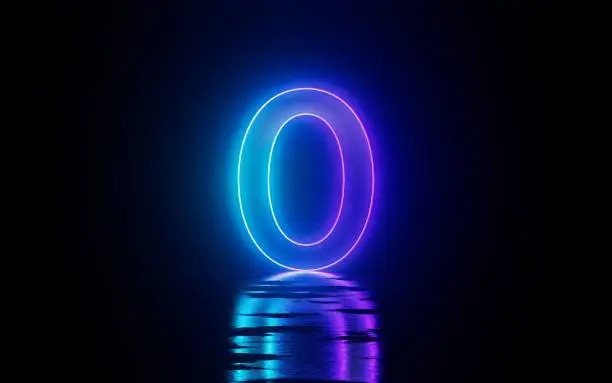Imagine staring into the treetops, binoculars raised, expecting to see a bird, but you see nothing. It’s not a vague feeling of absence, but a specific, conscious recognition that something should be there and isn’t. This oddly powerful moment, when your brain registers the absence of something, g—is more than just disappointment. It is a profound neurological experience, one that opens a door to a deeper understanding of how the human mind interprets the world.
The concept of ‘nothing,’ particularly as embodied by the number zero, presents a rare and captivating opportunity to delve into the intersection of mathematics, perception, and consciousness. Far from being a mere placeholder, zero is a complex construct with a rich history of philosophical resistance, scientific utility, and cognitive intricacy. From ancient clay tablets to the inner workings of the modern brain, Zero unveils how our minds grapple not just with what is, but with what isn’t—and why that matters so profoundly.
Tracing the Origins of Zero in Civilization
The story of zero, a concept that would later become a cornerstone of mathematics and philosophy, begins in the ancient land of Mesopotamia. The Sumerians, in their quest to develop a positional number system, faced a unique challenge: how to denote the absence of a quantity in a specific position? Their solution, though seemingly simple, was revolutionary—a symbol to represent absence in a particular position. This early concept of marking ‘nothing’ was the seed from which one of the most significant innovations in human thought would sprout.
However, zero did not travel an easy road. When the concept moved westward, it clashed with the rigid philosophies of Ancient Greece. Greek thinkers, deeply immersed in geometry and tangible objects, had no patience for abstraction. Aristotle famously denied the existence of a vacuum, arguing that nature abhors it. Thus, the notion of zero, of emptiness, of non-being, found no shelter in Greek logic or mathematics.
India: The Fertile Ground Where Nothing Took Root
While the Greeks resisted zero, Indian philosophers and mathematicians embraced it. Their worldview allowed space—literally and metaphorically—for nothingness. Different words in Sanskrit expressed different types of emptiness, from spiritual voids to spatial gaps. In this cultural and intellectual climate, zero became more than a placeholder. Mathematician Brahmagupta formalized its properties: subtracting a number from itself yields zero, and multiplying by zero erases everything—insights that eventually evolved into broader mathematical systems.
This acceptance was pivotal. It enabled zero to transition from a passive mark to an active number, with defined rules and operations. The abstract concept of nothing became, paradoxically, something: a usable, powerful entity in computation.
Europe’s Reluctant Adoption of Emptiness
When zero finally arrived in Europe via trade routes and thinkers like Fibonacci, it faced new theological resistance. Christian scholars saw “nothing” as a blasphemous idea—something opposed to God, who created the world from nothing. Figures like St. Augustine even associated nothingness with evil, equating it with the devil.
Despite elite resistance, practical needs prevailed. Merchants and accountants discovered that double-entry bookkeeping, a system reliant on zero, revolutionized financial tracking. This practical utility eventually forced intellectuals to embrace zero. By the time Newton and Leibniz developed calculus in the 17th century, zero was no longer taboo. It had become essential.
Zero in the Brain: A New Frontier of Neuroscience
In recent years, neuroscience has begun to explore how the human brain represents zero, not as a concept in mathematics, but as an element of perception. Studies involving monkeys showed that certain neurons respond only to empty sets—no dots on a screen—ignoring other quantities. These “zero neurons” reveal that the brain processes nothing but the absence of activity, but with its distinct neural signature.
Similar research in humans supports these findings. Brain scans show that zeros, whether symbolic (like the numeral 0) or conceptual (an empty visual field), activate specific areas in the parietal and frontal cortices. This suggests the brain treats zero as a unique entity, separate from other numbers.
Why Children Struggle to Grasp Nothing
The developmental trajectory of zero underscores its complexity. While young children easily learn to count tangible objects, grasping zero proves far more elusive. Studies show that even preschoolers who understand that zero means “nothing” still struggle to treat it as a number. They may say one is the smallest number, and comparisons involving zero often yield random guesses.
This struggle reflects how zero doesn’t correspond to visible quantities. No one buys “zero apples.” Understanding zero requires abstract reasoning—a mental leap away from the physical world into the domain of concepts. Even adults show cognitive friction: classifying zero as even or odd takes longer and results in more mistakes than with other numbers.
The Link Between Zero and Absence Detection
Intriguingly, the cognitive mechanisms used to understand zero seem closely tied to how we detect absences in our environment. Experiments show that humans are much better at noticing added features than missing ones. A mistyped letter in a word (e.g., “ONGE” instead of “ONCE”) is easier to spot than a missing letter (“STRANCER” instead of “STRANGER”).
This tendency to overlook what’s not there extends across species. Pigeons, rats, monkeys, and even honeybees demonstrate difficulty detecting absences compared to presences. Our brains are wired to see “something,” not “nothing.” Yet, paradoxically, understanding zero—an absence—is essential to higher cognitive functions.
Conscious Absence: A Window into Awareness
What does it mean to become aware of something not being there? Neuroscience suggests that perceiving absence isn’t passive. Instead, it requires active engagement of specific neural networks. When people consciously report not seeing a stimulus, their brains still light up, in a different pattern than when they perceive something.
This has led to theories like the Perceptual Reality Monitoring (PRM) and Higher-Order State Space (HOSS) models. These suggest that a metacognitive system in the brain—essentially a built-in fact-checker—evaluates sensory input and determines whether something is truly perceived or absent. Absence, then, becomes a conscious experience, not just a lack of sensation.
From Primitive Sense to Symbolic Thought
How did humans evolve the ability to represent absence symbolically? Researchers believe the symbolic concept of zero likely evolved from earlier, non-symbolic forms of absence detection. Infants and animals can track quantities and notice discrepancies, but the leap to naming and manipulating “zero” as a number came much later.
Brain imaging studies using magnetoencephalography have shown overlapping neural activity between symbolic zero (the number) and empty sets (no visual items). This supports the idea that our metaphorical understanding of zero emerged from older, more basic perceptual systems designed to notice when something is missing.
The Role of Zero in Measuring the Mind
Could our ability to understand zero serve as a benchmark for consciousness? Some theorists argue that the concept of zero may be one of the simplest forms of abstract reasoning. It reflects not just a numerical void but an awareness of potential presence—and its absence. To say “there is zero” means to make a statement about reality, which is filtered through perception and cognition.
This raises fascinating questions: Could recognizing zero be a hallmark of conscious awareness? If animals like bees can grasp the idea of zero, do they possess a rudimentary form of consciousness? And what does this mean for AI systems that manipulate zero computationally but do not “know” absence?
Zero as a Cognitive Keystone
As it turns out, the brain systems responsible for perceiving numbers also help regulate our attention, expectations, and perception of reality. These systems assess not just how many things are present but whether anything is present at all. When these networks fail to register sufficient input, they don’t merely stay silent. They actively declare: nothing is here.
This might be why zero remains cognitively taxing, emotionally loaded, and philosophically rich. It bridges sensory awareness and symbolic thought, blending perception, language, and memory. It’s a number, yes, but it’s also a concept. In some sense, it is among the most powerful “symbols of consciousness”.
Conclusion: Seeing Nothing, Understanding Everything
From clay tablets in Mesopotamia to cutting-edge neuroscience labs, zero has charted an extraordinary journey. It is both ancient and modern, simple yet enigmatic. As a number, it underpins our mathematical systems; as a concept, it exposes the very architecture of the mind. It challenges our assumptions about reality, presence, and what it means to be aware.
So the next time you scan the trees and find no bird, remember: your brain is doing something profoundly complex. It’s recognizing absence. It’s invoking the “power of 0“. It’s operating on principles deeper than arithmetic—principles that allow us to reason abstractly, perceive subtly, and, ultimately, to be human. In those moments, we’re not just understanding zero; we’re engaging with the very fabric of awareness—proof that even “real zeros” can mean something, and even “anything to the zero power” still results in one remarkable truth: nothing really does matter.

